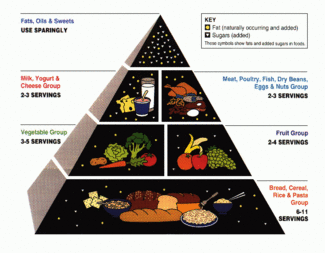Healthy diet - Simple English Wikipedia, the free encyclopedia

A healthy diet or balanced diet. is a diet (what you eat) that contains the right amounts of all the food groups. It includes fruits, vegetables, grains, dairy products, and protein. It does not include too much or too little of any kind of food.[1] Eating wrong amounts of a food group, whether it be too much or too little, is called an 'unhealthy diet' or an 'imbalanced diet'. A healthy diet is one that includes more foods that come from plants and fewer convenience foods.[2]
Basic nutrition
[change | change source]What is known about nutrition and diet keeps changing as more is learned.[3] However, basic nutrition remains much the same.[3] The best advice is to talk to a doctor or dietitian for personalized information based on an individual's lifestyle, health, and food likes and dislikes.[3]
- Basic nutrition begins with a diet based on the major food groups that includes vegetables, whole grains, and dairy products.[3] It should also have lean protein such as beans, legumes, nuts and seeds plus healthy fats.[3]
- A basic nutrition plan should include guidelines for how much food from each group to eat.[3]
- Foods should be those that can be found in local grocery stores instead of specialty and gourmet food stores.[3]
- A basic food plan should be based on an individual's budget, lifestyle and (healthy) preferences.[3]
- Drink plenty of water.[4] Drink fewer Soft drinks, energy drinks and sports drinks which usually have sugar.[4]
- Read the food labels to see what is in the foods.[4] For example, labels usually show what foods are lower in sodium such as in soup, bread, and frozen meals.[4]
- A healthy diet should include seafoods (such as salmon, tuna, and trout) and shellfish (such as crab, mussels, and oysters). Seafood has protein, minerals, and omega-3 fatty acids which are heart-healthy.[4]
- Basic nutrition should contain balanced amounts of macronutrients for energy.[5] Carbohydrates are one of the three macro-nutrients in the human diet (fat and protein are the other two).[5]
- A healthy diet can replace dieting for weight loss.[6] Eating healthy, along with physical exercise and practicing moderation, can lead to better health in the long run.[6]
Special diets
[change | change source]There are some diets made for people with some diseases. Here are some examples:
- DASH diet (Dietary Approaches to Stop Hypertension)
- Gluten-free diet (Coeliac disease)
- Ketogenic diet (Epilepsy)
Related pages
[change | change source]References
[change | change source]- ↑ "Natural, Organic Healthy Living & Diet". Archived from the original on 2018-02-11. Retrieved 2007-12-11.
- ↑ "14 Keys to a Healthy Diet". University of California Berkeley Wellness. Retrieved 25 April 2016.
- ↑ 3.0 3.1 3.2 3.3 3.4 3.5 3.6 3.7 Mayo Clinic staff. "Nutrition basics". Mayo Foundation for Medical Education and Research. Retrieved 25 April 2016.
- ↑ 4.0 4.1 4.2 4.3 4.4 "How to Eat Healthy". President's Council on Fitness, Sports & Nutrition. Retrieved 25 April 2016.
- ↑ 5.0 5.1 "Carbohydrates". The European Food Information Council. Archived from the original on 14 April 2016. Retrieved 25 April 2016.
- ↑ 6.0 6.1 Kathleen M. Zelman (17 June 2010). "Dieting Is Out; Healthy Eating Is In". WebMD, LLC. Retrieved 25 April 2016.


 French
French Deutsch
Deutsch